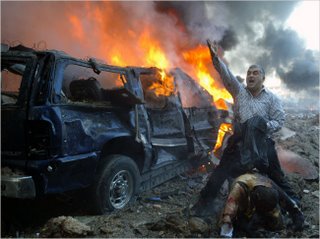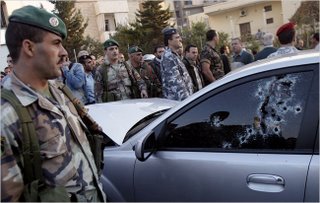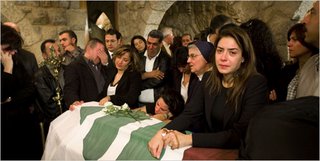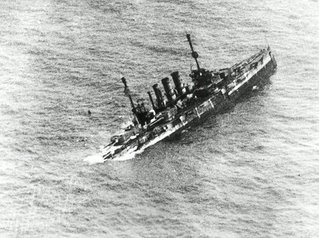And now for something completely different...
Make sure you see the "sketch" of the leprechaun?
"Could be a crackhead who got ahold of da wrong stuff!"






But what do I know."
Well, a helluva a lot more than most of the policy makers in this country, it seems. As you may recall, SJS and myself made a wager with regard to the Valour-IT Project. The deal of course being that if my Zoomies won, he would defile the pages of his blog with a fragile, no-tailhookin' Air Farce aircraft, while if, through some miracle, his Squids pulled off a victory, I'd besmirch the honor of this blog with an ugly no-class Navy shadow of an airplane.
As you may recall, SJS and myself made a wager with regard to the Valour-IT Project. The deal of course being that if my Zoomies won, he would defile the pages of his blog with a fragile, no-tailhookin' Air Farce aircraft, while if, through some miracle, his Squids pulled off a victory, I'd besmirch the honor of this blog with an ugly no-class Navy shadow of an airplane. impressive, and you should head on over there to take a look. SJS's choice of aircraft for me was the Grumman F4F Wildcat, a fine choice if I do say so myself. A tough little bird that, while outclassed by its adversaries such as the A6M "Zero," still managed to hold the line in the Pacific and contributed to our first victories at Midway and Guadalcanal that started the turning of the tide. The F4F continued to serve on escort carriers for the remainder of the war where it performed yeoman service as a CAS aircraft flying off those carriers in support of countless amphibious assaults and helped hunt down U-boats in the Atlantic. Without further ado, the Wildcat...
impressive, and you should head on over there to take a look. SJS's choice of aircraft for me was the Grumman F4F Wildcat, a fine choice if I do say so myself. A tough little bird that, while outclassed by its adversaries such as the A6M "Zero," still managed to hold the line in the Pacific and contributed to our first victories at Midway and Guadalcanal that started the turning of the tide. The F4F continued to serve on escort carriers for the remainder of the war where it performed yeoman service as a CAS aircraft flying off those carriers in support of countless amphibious assaults and helped hunt down U-boats in the Atlantic. Without further ado, the Wildcat... w monoplane was designated the XF4F-2, but was still inferior to the Buffalo, largely due to powerplant issues. Grumman returned to the drawing board and launched into an extensive redesign, installing a more powerful P&W Twin Wasp supercharged engine. The increased weight from the new engine and its associated supercharger, intercooler, and ductwork led to increases in wing span and area and a redesign of the tail surfaces. This new design was given the designation of XF4F-3, and in August 1939 the Navy awarded an intial contract for 54 F4F-3 airframes. The first production fighter flew in Febuary of 1940.
w monoplane was designated the XF4F-2, but was still inferior to the Buffalo, largely due to powerplant issues. Grumman returned to the drawing board and launched into an extensive redesign, installing a more powerful P&W Twin Wasp supercharged engine. The increased weight from the new engine and its associated supercharger, intercooler, and ductwork led to increases in wing span and area and a redesign of the tail surfaces. This new design was given the designation of XF4F-3, and in August 1939 the Navy awarded an intial contract for 54 F4F-3 airframes. The first production fighter flew in Febuary of 1940. om the French order on the production line when France capitulated. There aircraft were folded into the RN's order of 100 Martlets, as they called the F4F. In October of 1940, due to a shortage of two-stage superchargers, Grumman came out with the F4F-3A which was a variant that featured a modified engine that was equipped with a more primitive single-stage two speed supercharger. The USN ordered 65, with an additional 30 going to Greece. As was common with war material deliveries early in the war, the aircraft didn't arrive before the fall of Greece, so, as often was the case in these kind of events, the aircraft were delivered into British service.
om the French order on the production line when France capitulated. There aircraft were folded into the RN's order of 100 Martlets, as they called the F4F. In October of 1940, due to a shortage of two-stage superchargers, Grumman came out with the F4F-3A which was a variant that featured a modified engine that was equipped with a more primitive single-stage two speed supercharger. The USN ordered 65, with an additional 30 going to Greece. As was common with war material deliveries early in the war, the aircraft didn't arrive before the fall of Greece, so, as often was the case in these kind of events, the aircraft were delivered into British service. , and an additional 2 .50 machine guns. The increase in guns was dictated by the British, who needed the extra firepower against sturdy German and Italian fighters. However, the ammunition load did not increase; this meant that instead of the F4F-3's 450 rounds per gun and approximately 34 seconds of firing time, pilots would now only have 240 rounds per gun, with less than 20 seconds of firing time. As Jimmy Thatch, one of the most famous Wildcat pilots (more on that later) said, "A pilot who cannot hit with four guns will miss with eight". The folding wings and extra guns increased weight, which led to degraded performance. In line with the American view of war, the extra firepower and increase of number of F4Fs per carrier offered by the folding wings outweighed performance considerations and the F4F-4 became the definitive (Grumman-built) version.
, and an additional 2 .50 machine guns. The increase in guns was dictated by the British, who needed the extra firepower against sturdy German and Italian fighters. However, the ammunition load did not increase; this meant that instead of the F4F-3's 450 rounds per gun and approximately 34 seconds of firing time, pilots would now only have 240 rounds per gun, with less than 20 seconds of firing time. As Jimmy Thatch, one of the most famous Wildcat pilots (more on that later) said, "A pilot who cannot hit with four guns will miss with eight". The folding wings and extra guns increased weight, which led to degraded performance. In line with the American view of war, the extra firepower and increase of number of F4Fs per carrier offered by the folding wings outweighed performance considerations and the F4F-4 became the definitive (Grumman-built) version. The picture to the left may look rather ordinary, but in fact the pilots are probably the two most famous men to ever fly the Wildcat: Adm. (then LCdr.) John Thach and LCdr. (then Lt.) Edward "Butch" O'Hare. And this provides a convenient stepping off point into the Wildcat's extensive combat career. However, we'll have to go back in time a bit from those two gentlemen's exploits.
The picture to the left may look rather ordinary, but in fact the pilots are probably the two most famous men to ever fly the Wildcat: Adm. (then LCdr.) John Thach and LCdr. (then Lt.) Edward "Butch" O'Hare. And this provides a convenient stepping off point into the Wildcat's extensive combat career. However, we'll have to go back in time a bit from those two gentlemen's exploits. st ace and flying winner of the CMH. On 20 Feb. 1942, the USS Lexington was cruising in waters near New Ireland when it began to be attacked by Japanese long range bombers out of Rabaul. The Lex's CAP was busy engaging enemy bombers at a stand-off distance when suddenly the carrier's radar picked up 8 contacts only 12 miles away and closing fast. The only fighters within range to intercept were Butch's and his wingman. Unfortunately, as I mentioned above, the earlier Wildcat variants' guns had a tendency to jam. This was the case here, as Butch's wingman's guns jammed, meaning that Butch was literally the only line of defense for the Lex. Using deflection shooting, Butch was able to down 5 of the Japanese bombers and damage a sixth, breaking up the attack. Quite an impressive feat of shooting considering that this meant that he used only 60 rounds per kill.
st ace and flying winner of the CMH. On 20 Feb. 1942, the USS Lexington was cruising in waters near New Ireland when it began to be attacked by Japanese long range bombers out of Rabaul. The Lex's CAP was busy engaging enemy bombers at a stand-off distance when suddenly the carrier's radar picked up 8 contacts only 12 miles away and closing fast. The only fighters within range to intercept were Butch's and his wingman. Unfortunately, as I mentioned above, the earlier Wildcat variants' guns had a tendency to jam. This was the case here, as Butch's wingman's guns jammed, meaning that Butch was literally the only line of defense for the Lex. Using deflection shooting, Butch was able to down 5 of the Japanese bombers and damage a sixth, breaking up the attack. Quite an impressive feat of shooting considering that this meant that he used only 60 rounds per kill. than hold their own against the nimble Zero and is in fact still a valid WVR combat maneuver today. This maneuver contributed to the large kill ratio the Wildcat was able to rack up at Midway and in service with the outnumbered Cactus Air Force at Guadalcanal.
than hold their own against the nimble Zero and is in fact still a valid WVR combat maneuver today. This maneuver contributed to the large kill ratio the Wildcat was able to rack up at Midway and in service with the outnumbered Cactus Air Force at Guadalcanal. untless convoys and helping support numerous amphibious landings. However, it was at the Battle of the Leyte Gulf and the stand of Taffy 3 where the Wildcats took part in the most famous escort carrier action of the war, when Adm. Clifton Sprague's force of 6 CVEs, 3 DDs and 4 DEs fought off the IJN center force off Samar, saving the Leyte beachhead and sealing the fate of the IJN. Wildcats from the composite squadrons, along with Avenger torpedo-bombers, made numerous bombing and strafing runs on the Japanese ships, hoping to cause whatever damage they could and distract from the relatively defenseless CVEs. The aircraft continued to make runs even after their ammunition was expended, hoping to keep up the pressure on the Japanese force.
untless convoys and helping support numerous amphibious landings. However, it was at the Battle of the Leyte Gulf and the stand of Taffy 3 where the Wildcats took part in the most famous escort carrier action of the war, when Adm. Clifton Sprague's force of 6 CVEs, 3 DDs and 4 DEs fought off the IJN center force off Samar, saving the Leyte beachhead and sealing the fate of the IJN. Wildcats from the composite squadrons, along with Avenger torpedo-bombers, made numerous bombing and strafing runs on the Japanese ships, hoping to cause whatever damage they could and distract from the relatively defenseless CVEs. The aircraft continued to make runs even after their ammunition was expended, hoping to keep up the pressure on the Japanese force. 50 cal. machine guns, and, in typical American fashion, provided much better protection in the form of self-sealing gas tanks and armor for the pilot. Also, the F4F featured a homing beacon that was the saving grace of many Navy pilots caught in poor weather conditions and running low on fuel. The Wildcat did have its shortcomings: the previous mentioned jamming issues, the controversy over number of guns and ammunition capacity, and its narrow-track hand-cranked landing gear, which led to landing accidents being a fairly common occurance.
50 cal. machine guns, and, in typical American fashion, provided much better protection in the form of self-sealing gas tanks and armor for the pilot. Also, the F4F featured a homing beacon that was the saving grace of many Navy pilots caught in poor weather conditions and running low on fuel. The Wildcat did have its shortcomings: the previous mentioned jamming issues, the controversy over number of guns and ammunition capacity, and its narrow-track hand-cranked landing gear, which led to landing accidents being a fairly common occurance.
